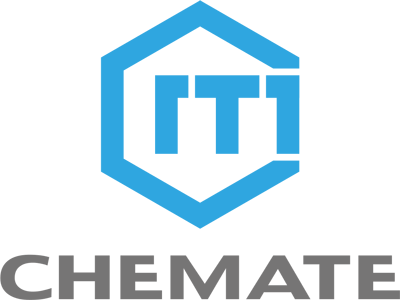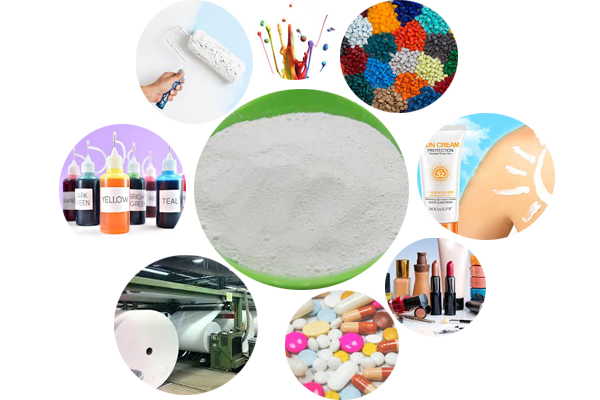Home » Titanium Dioxide
>>> Main Types: Rutile TiO2, Anatase TiO2
>> Feature one: Best whiteness, brightness and opacity
>> Feature two: Less prone to chemical changes, always white
>> Feature three: Strong adhesion and good covering ability
>> Feature four: Better UV masking effect
>> Feature five: High temperature resistance, excellent electrical properties
>>> Product Description
Titanium dioxide (Tio2), is a kind of white inorganic pigment. With the characteristics of white non-toxic, best opacity, best whiteness and brightness, it is considered to be the best white pigment in the world now. At present, it is widely used in paint and coatings, plastics, paper, printing inks, chemical fibers, rubber, cosmetics and other industries. In addition, because of its high melting point, it is also used to make refractory glass , Glaze, enamel, pottery clay, high temperature resistant laboratory utensils, etc.
As a leading manufacturer, Chemate titanium dioxide for sale has two crystal forms, they are rutile titanium dioxide and anatase titanium dioxide. But they are also divided into general grade, paint and coating grade, masterbatch grade, PVC grade and ceramic grade. Please check more details below or cotact us to get the price online.
- Rutile Grade Titanium Dioxide
- Anatase Titanium Dioxide
| Item | Rutile TiO2(General Grade) |
|---|---|
| True Density | 4.1 g/cm3 |
| Apparent Density | 0.7~1.0 g/cm3 |
| Surface Treatment | Silicon, aluminum inorganic coating & Special organic treatment |
| TiO2 Content, % | ≥94.0 |
| Rutile Content, % | ≥98.0 |
| Color(Compared with the Standard Sample) ∆L*(Sample-Standard) ∆s=(∆a2+∆b2)0.5 | Not lower than ≥-0.3 ≤0.5 |
| Volatile at 105℃, % | ≤0.5 |
| Water Soluble Objects, % | ≤0.5 |
| Residue on Sieve(45µm Sieve Pore) % | ≤0.1 |
| PH Value of Aqueous Suspension | 6.5-8.5 |
| Lightness, % | ≥96.0 |
| Oil Absorption, g/100g | ≤21 |
| Tint Reducing Power(Ranolds) | ≥1800 |
| Item | Rutile TiO2(Masterbatch Grade) |
|---|---|
| True Density | 4.1 g/cm3 |
| Apparent Density | 0.7~1.0 g/cm3 |
| Surface Treatment | Silicon, aluminum inorganic coating & Special organic treatment |
| TiO2 Content, % | ≥95.0 |
| Rutile Content, % | ≥98.0 |
| Color(Compared with the Standard Sample) ∆L*(Sample-Standard) ∆s=(∆a2+∆b2)0.5 | Not lower than ≥-0.3 ≤0.5 |
| Volatile at 105℃, % | ≤0.3 |
| Water Soluble Objects, % | ≤0.5 |
| Residue on Sieve(45µm Sieve Pore) % | ≤0.1 |
| PH Value of Aqueous Suspension | 6.2-9.0 |
| Lightness, % | ≥97.0 |
| Oil Absorption, g/100g | ≤19 |
| Tint Reducing Power(Ranolds) | ≥1850 |
| Item | Rutile TiO2 (Paint & Coating Grade) |
|---|---|
| True Density | 4.1 g/cm3 |
| Apparent Density | 0.7~1.0 g/cm3 |
| Surface Treatment | Silicon, aluminum inorganic coating & Special organic treatment |
| TiO2 Content, % | ≥93.0 |
| Rutile Content, % | ≥98.0 |
| Color(Compared with the Standard Sample) ∆L*(Sample-Standard) ∆s=(∆a2+∆b2)0.5 | Not lower than ≥-0.3 ≤0.5 |
| Volatile at 105℃, % | ≤0.5 |
| Water Soluble Objects, % | ≤0.5 |
| Residue on Sieve(45µm Sieve Pore) % | ≤0.1 |
| PH Value of Aqueous Suspension | 6.0-8.5 |
| Lightness, % | ≥96.0 |
| Oil Absorption, g/100g | ≤21 |
| Tint Reducing Power(Ranolds) | ≥1850 |
| Item | Anatase TiO2(General Grade) |
|---|---|
| TiO2 Content, % | ≥98.0 |
| Color(Compared with the Standard Sample) | Approximate |
| Tint Reducing Power(Compared with the Standard Sample) | ≥100 |
| Volatile at 105℃, % | ≤0.46 |
| Water Soluble Objects, % | ≤0.5 |
| PH Value of Aqueous Suspension | 6.5-8.0 |
| Oil Absorption, g/100g | ≤26 |
| Dispersity, Um | ≤15 |
| Item | Anatase TiO2(Paint and Coating Grade) |
|---|---|
| TiO2 Content, % | ≥98.0 |
| Color(Compared with the Standard Sample) | Not lower than |
| Whiteness(Compared with the Standard Sample) | ≥95 |
| Tint Reducing Power(Compared with the Standard Sample) | ≥100 |
| Volatile at 105℃, % | ≤0.46 |
| Water Soluble Objects, % | ≤0.5 |
| PH Value of Aqueous Suspension | 6.5-8.0 |
| Oil Absorption, g/100g | ≤23 |
| Covering Power | ≤27 |
| Item | Anatase TiO2(Masterbatch Grade) |
|---|---|
| TiO2 Content, % | ≥98.0 |
| Color(Compared with the Standard Sample) | Not lower than |
| Whiteness(Compared with the Standard Sample) | ≥96 |
| Tint Reducing Power(Compared with the Standard Sample) | ≥100 |
| Volatile at 105℃, % | ≤0.5 |
| Water Soluble Objects, % | ≤0.5 |
| PH Value of Aqueous Suspension | 6.5-8.0 |
| Oil Absorption, g/100g | ≤26 |
| Covering Power | ≤30 |
| Item | Anatase TiO2(PVC Grade) |
|---|---|
| TiO2 Content, % | ≥98.0 |
| Color(Compared with the Standard Sample) | Not lower than |
| Whiteness(Compared with the Standard Sample) | ≥96 |
| Tint Reducing Power(Compared with the Standard Sample) | ≥100 |
| Volatile at 105℃, % | ≤0.5 |
| Water Soluble Objects, % | ≤0.5 |
| PH Value of Aqueous Suspension | 6.5-8.0 |
| Oil Absorption, g/100g | ≤26 |
| Covering Power | ≤30 |
| Item | Anatase TiO2(Ceramic Grade) |
|---|---|
| TiO2 Content, % | ≥98.0 |
| Sulphur Content, % | ≤0.06 |
| Fe2O3 Content, % | ≤0.1 |
| Residue on Sieve(0.045mm Sieve Pore) % | ≤0.5 |
| PH Value of Aqueous Suspension | 6.5-8.0 |
| High Temperature Resistance(1200℃/one hour) | Doesn’t turn grey |
>>> Application of Titanium Dioxide Pigment
- Titanium dioxide has strong adhesion, which is not prone to chemical changes and always white. So it is widely used in costings, plastics, papermaking, printing inks, chemical fiber, rubber, floor coverings, roofing materials, cosmetics and other industries.
- With high melting point, it is used to make refractory glass, glaze, enamel, clay, high temperature resistant laboratory utensils, etc…
- With good UV shielding effect, it is often incorporated into textile fibers as a sunscreen, and ultrafine titanium dioxide powder is also added to sunscreen cream to make sunscreen cosmetics.
- Food grade Tio2 can be used as white pigment in all foods.
>>> Preparation Process of Titanium Dioxide Powder
1. Sulfuric acid process:
First, the ilmenite powder and concentrated sulfuric acid are subjected to acid hydrolysis reaction to generate titanium hydrogen sulfate. It is then hydrolyzed to metatitanic acid. Finally, the titanium dioxide product can be obtained by burning and crushing. The sulfuric acid method has the advantages of abundant raw materials, low price and availability, mature technology, simple equipment and easy operation.
2. Chlorination process
mixing natural rutile or high-titanium slag raw materials with carbon or petroleum coke for high-temperature chlorination. It produces titanium tetrachloride, which is then oxidized at high temperature to produce titanium dioxide. Finally, titanium dioxide powder is obtained by filtration, water washing, drying and crushing. The oxidation step in the chlorination method controls the particle size distribution and crystal structure, so that it can produce titanium dioxide with high hiding power, blue color and high color strength.
>>> Why Choose Chemate Company
- Rich experience in titanium dioxide production and advanced research and development capacity.
- The most advanced production technology and complete production equipment, scientific and standardized layout, the overall level is in the lead in the same industry in China.
- Quality assurance. ISO9001 international quality standard system certification, ISO14001 environmental management system certification, GB/T28001 standard.
- Variety complete, timely supply, reasonable price and excellent pre-sales and after-sales service.
Leave A Message For Us
If you are looking for different types of pigments, please contact us any time or leave a message below. And we will give you a reply within 24 hours. Thanks!

